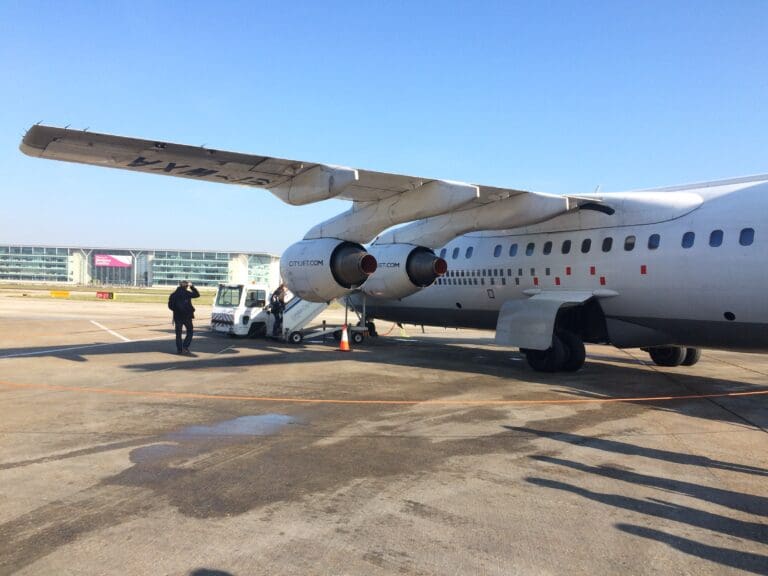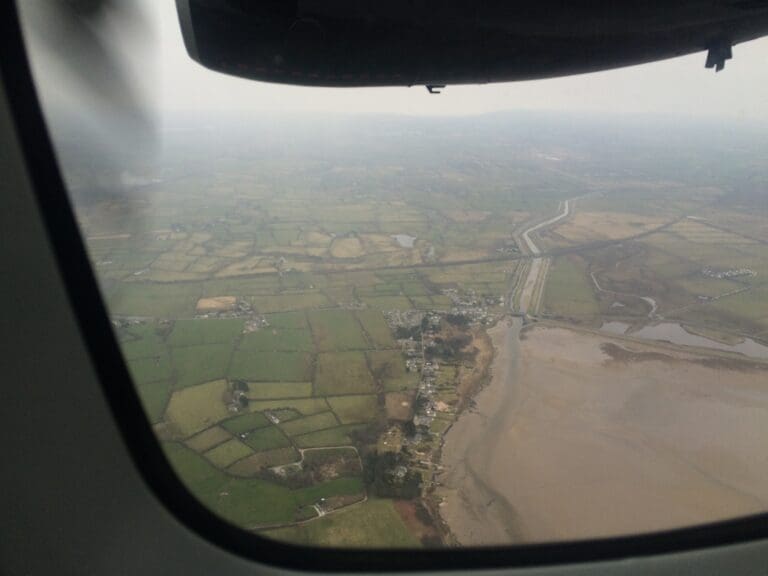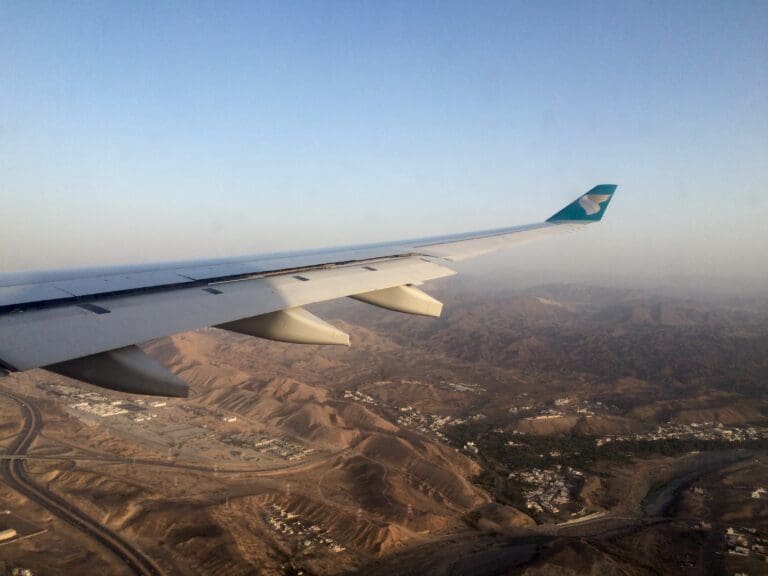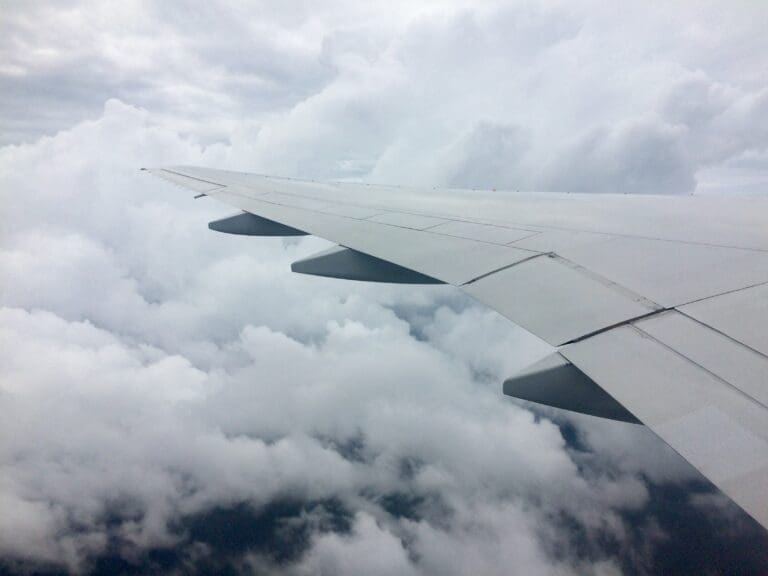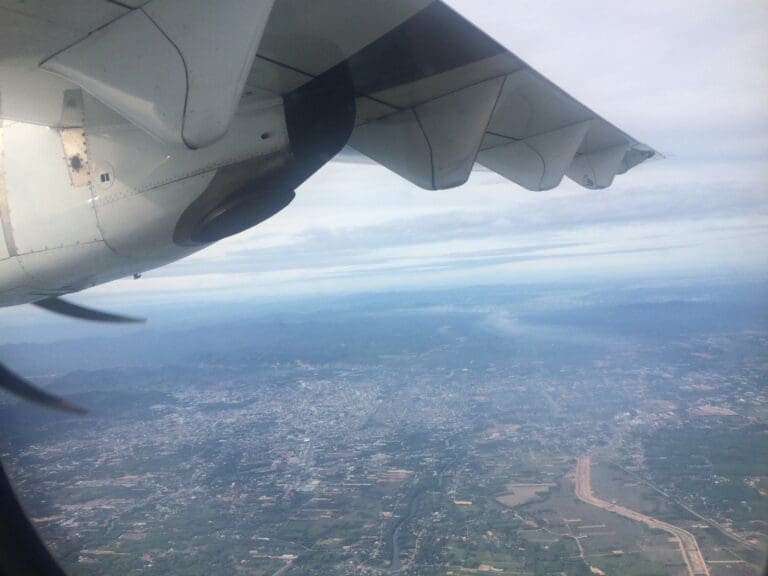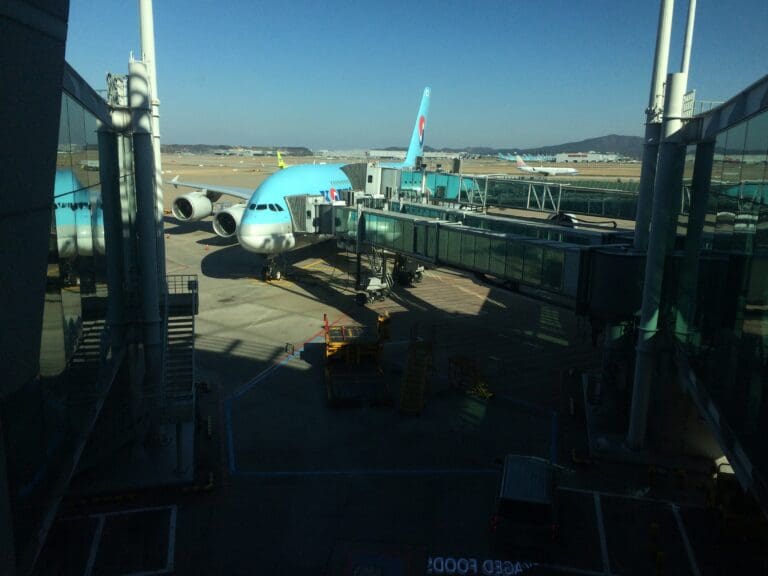An Overnight Hop on Korea’s Largest LCC: Daegu to Beijing with Jeju Air
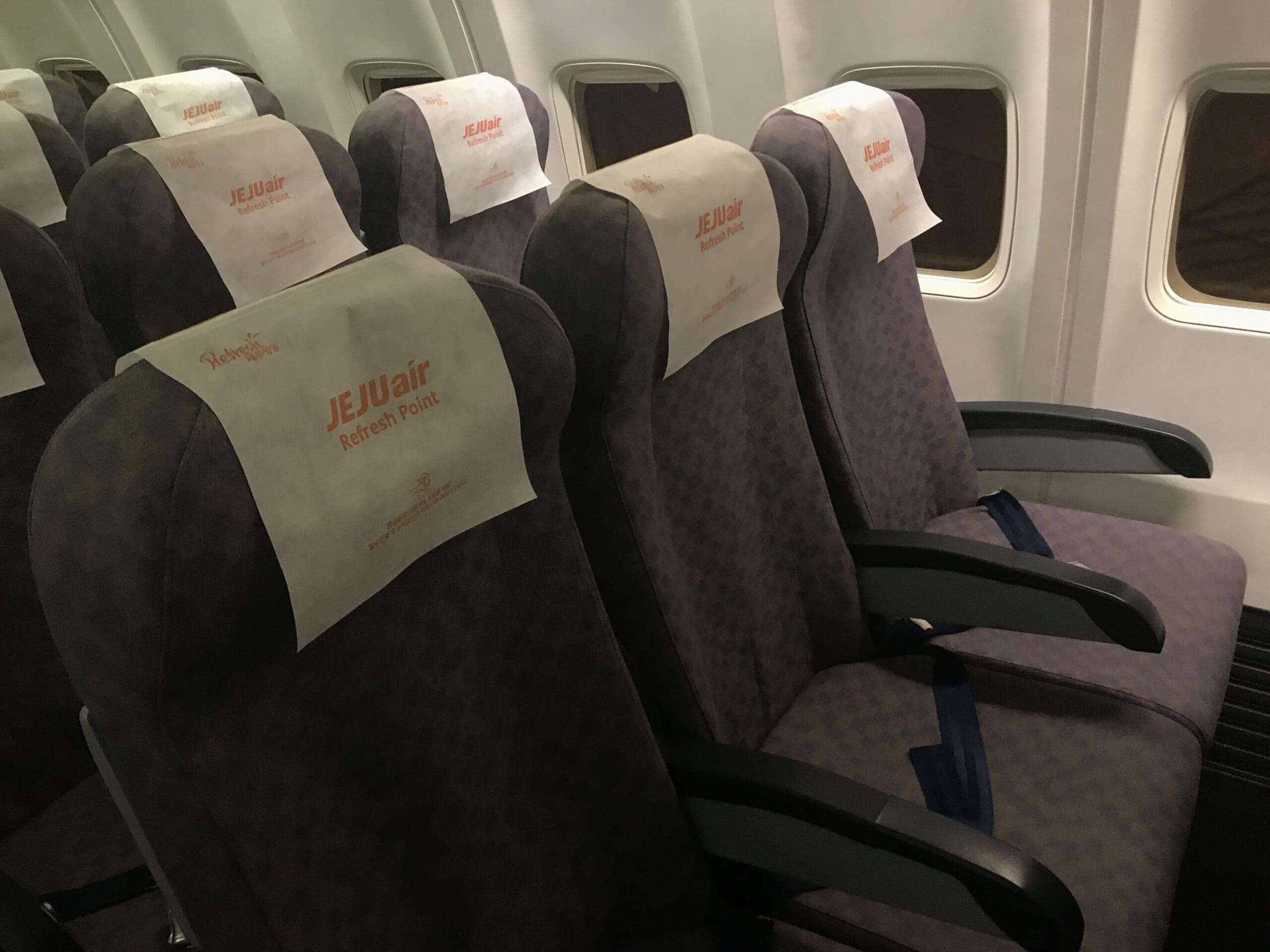
Background
At the end of my compulsory year in Seoul as part of my undergraduate degree, in August 2017 the time came for me to head back to the UK. Whilst I had initially been drawn to Air China’s flights via Beijing thanks to their cheap cost, having saved some money I decided to come up with a slightly less direct routing that would see me fly back to the UK with stops in China, Kazakhstan and Belarus, spending several days in the middle country. This routing would see me sample a range of interesting aircraft including a SCAT Airlines Boeing 737-500, a Southern Sky Airlines Antonov An-24 and a Bek Air Fokker 100 before heading back to the UK with a stop in Minsk onboard a Belavia Boeing 737-800 and Boeing 737-500. To reach Xi’an from where I would catch the SCAT Airlines Boeing 737 Classic to Almaty, I did some experimenting which revealed that the cheapest options involved flying via Beijing. Seeing as I would be starting my journey in Seoul, my choice to fly from Daegu, located 237 kilometres to the southeast of Korea’s capital may seem a little strange, however, those flights from Seoul’s two airports to Beijing proved to be around £50 more expensive than Jeju Air’s evening flight from Daegu. Having previously flown with Jeju Air on three occasions prior to this flight, albeit all on short domestic hops, I had little reason not to fly with the carrier again and carried a rough idea of what to expect from the flight.
Booking
For the most part, Jeju Air’s website is simple and easy to use. Of course, being an LCC, the price quoted at first glance is soon added to, thanks to various taxes and other fees, likely bringing disappointment to many passengers. As with most LCCs, Jeju Air offers a range of optional extras including an extra bag (as with other Korean LCCs the airline offers all passengers a complimentary 15kg of hold luggage), an inflight meal and seat reservations priced between 2000 to 20,000 Won. After a quick and easy booking process, I paid for my flights and instantly received confirmation of my tickets via an email and KakaoTalk message.
The Journey to Daegu
Seeing as Daegu is Korea’s fourth largest city, those travelling to the city from Seoul are faced with a cornucopia of different public transportation options. Costing only 17000 won, the three-and-a-half-hour journey by express bus is perhaps the best option for those on a budget. However, considering that East Daegu train station is located only a couple of subway stops and a short bus journey away from the airport, I decided to opt for the train. Of the various rail options, Korail’s high-speed KTX services depart at very regular intervals and take under two hours to make this journey. However, these usually come with a rather significant price tag. The next train category, the modern and comfortable ITX-Saemaul trains stop and more stations than KTX services and often take slower routes, offering a similar journey time to the express buses albeit often with a ticket price twice as high as these. Finally, the cheapest and slowest long-distance train category in Korea takes the form of Mugunghwa services, named after Korea’s national flower. Stopping at every city, town and village they pass through at a speed that allows passengers to admire the scenery, they are perhaps a good option for those wanting to see Korea on a budget. In spite of their comparatively low cost, they offer the most comfortable ride of all of Korea’s regular trains, with large padded seats, a buffet car and private noraebang (singing) rooms. Costing only 21,000 won, I opted to take one of these services from Seoul to East Daegu station. Given my late evening departure from Daegu Airport, I settled for the 1550 departure from Seoul, which would see me arriving in Daegu at 1956 allowing for plenty of time to transfer to the airport.
Thanks to my long to-do list before I left Seoul, I had woefully neglected any travel preparation and when the morning of my departure day came around I spent the morning going from shop to shop trying to gather everything I would need for my journey.
Fortunately, Seoul Station is located only a stop away from my former apartment which meant that I would not have to spend too long in the blisteringly hot summer heat as I made my way to the station. That day was particularly hot and during the morning I received an emergency heat wave text message warning from the Korean government! After a quick trip on the Gyeongui Line, I disembarked at Korea’s largest station and made my way up to the mainline station area. Seeing as it was the summer travel period, the station was relatively busy although this did not seem to be overly crowded. Not wanting to splash out on the inflated costs for items purchased onboard the train, after arriving at the main station concourse I headed to one of the station’s convenience stores for some drinks and snacks to keep me going for the next four hours before heading down to the platform. Twenty minutes prior to the train’s departure time, at 1530, a powerful Korail Class 8200 locomotive rumbled into the platform pulling seven red and white empty carriages after its short journey from the depot at Susaek.
From the outside, the train seemed to be grubby, worn and a little battered with those carriages used for Mugunghwa services predating the ITX-Saemaul and KTX trains by a number of years. Inside, whilst these trains look rather dated and lack the modern conveniences of Korail’s other trains such as plug sockets and wifi, this appeared to be spotlessly clean whilst the seats were very well padded and offered a fantastic amount of legroom. At 1545 a prerecorded welcome announcement played in Korean and English and as the clock struck 1550, the train pulled away from Seoul Station and headed out under the shadow of nearby Namsan and its tall grey tower. From Seoul’s main terminus, the train soon headed passed through Youngsan, an area well known for its large US garrison before crossing over the wide Han River and stopping at Yeongdeungpo where the near-empty train became almost entirely full of early finishing workers, mostly heading off to Seoul’s satellite towns and cities in Gyeonggi province.
For those with an interest in history and politics, the train stopped at a number of notable places. Once the train left Seoul, its first stop was in Suwon, a city of 1.2 million and of historical significance, home to Hwaseong Fortress. From there the train soon stopped at Osan, home to a large USAF base before arriving at Pyeongtaek which hosts a large number of US Army troops. Continuing southwards, the train stopped at Cheonan, the namesake of the ill-fated corvette, the ROKS Cheonan and after a couple of hours the train arrived in Korea’s fifth largest city, Daejeon. Here the train emptied out a little before it continued southeast through Korea’s mountainous centre. After Daejeon, the train seemed to stop at every village and small town that the railway passed through. At each stop passengers filtered off and only a small number of people, if any, joined the train. Our arrival into Gumi, the hometown of military dictator Park Chung-hee and his daughter, the disgraced former president, Park Geun-hye signalled our arrival into North Gyeongsang, of which Daegu is the capital city.
After scenic dusk during the final stages of the journey, by the time the train pulled into Daegu, the sun had set and an announcement was made advising passengers not to confuse Daegu station with East Daegu station. Upon arriving at the former, most onboard alighted at the more central former station leaving an almost empty train for the five-minute journey to East Daegu where the train ended its journey from the capital three minutes behind schedule.
After disembarking I made my way up the escalators and followed signs for the metro which was located outside the main station next to the Shinsegae department store. After tapping in with my T-Money card I soon boarded a Line 1 metro train and disembarked two stops later at Ayanggyo Station, a short bus ride away from the airport. Less than thirty minutes after arriving at the East Daegu station I arrived outside the airport terminal building ending my long journey down from Seoul.
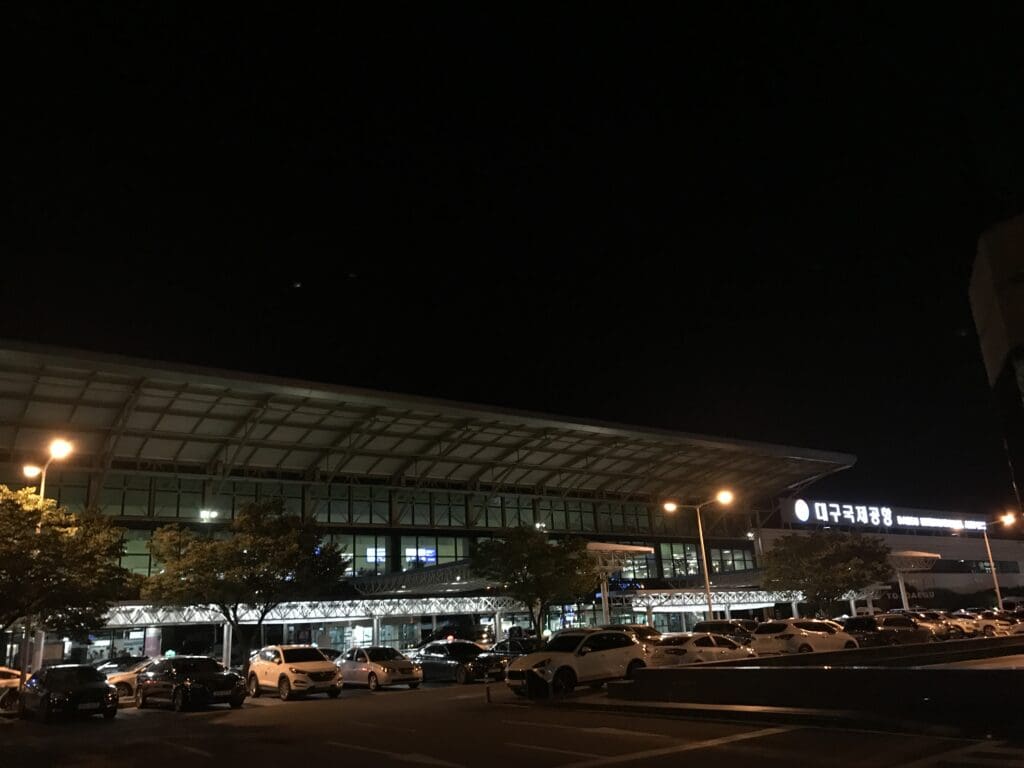
The Flight
As of summer 2017, Daegu Airport appeared to be doing rather well, with scheduled flights operated by Air Busan, Air China, Asiana Airlines, China Eastern, Jeju Air, Korean Air, T’Way and Tigerair Taiwan all serving the airport with international flights to China, Guam, Hong Kong, Japan, the Philippines and Taiwan. Despite the high number of flights, from the outside, the terminal appeared to be relatively small and once inside, the low ceilings of the airport’s check-in area made this feel far smaller than the terminal actually is. However, the spacious landing waiting area on the floor above gave the opposite impression.
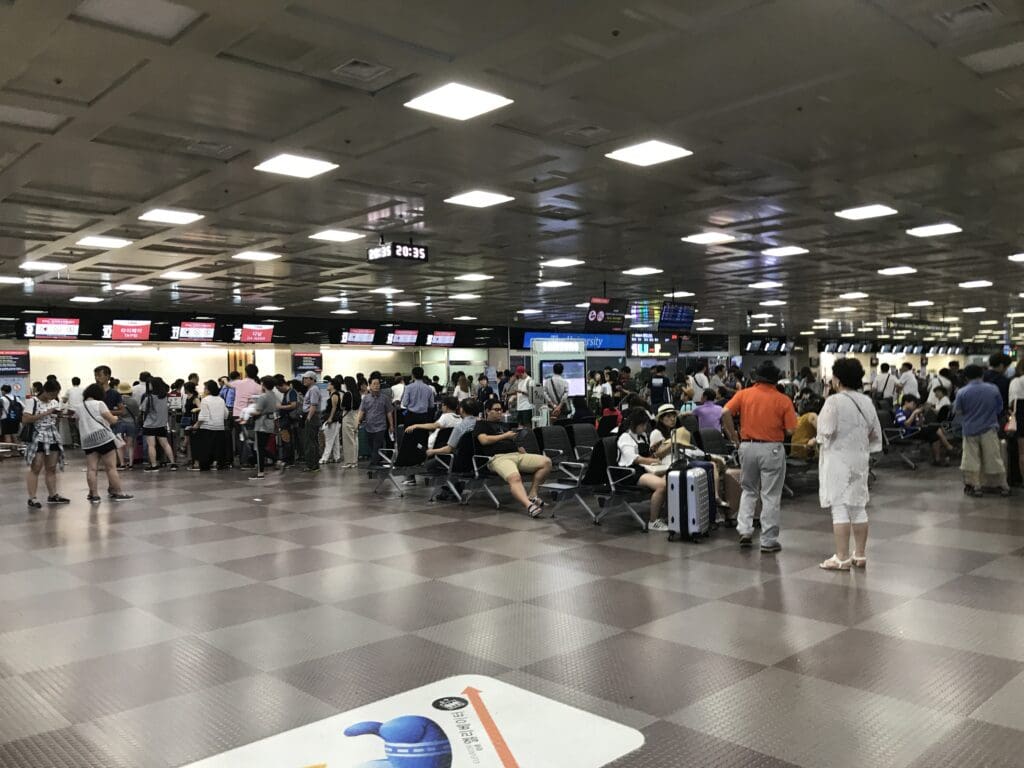
With evening flights to Cebu, Danang, Shanghai and Taipei on T’way Air and to Sanya on Air Busan, all of which were checking in at the same time, upon arriving at the airport I found the ground floor level to be incredibly busy with long queues of holidaymakers. Having arrived with plenty of time prior to my flight, at this time the Jeju Air check-in desks were closed, and with few seats available on the ground floor level, I decided to wait in the near-empty seating area upstairs where I passed the time on the airport’s fast complimentary wifi network. Eventually, I headed back downstairs and at 2110 Jeju Air’s three check-in desks opened and I joined a queue of around twenty or so people. Whilst those in front of me did not appear to have significant amounts of luggage, the queue seemed to move along relatively slowly and it took the best part of thirty minutes before I reached one of these desks. Once here, I was quickly checked-in by a rather cold staff member, however, ignoring the fact that my bag exceeded the complimentary 15kg allowance by 2kg, I could not make any complaints!
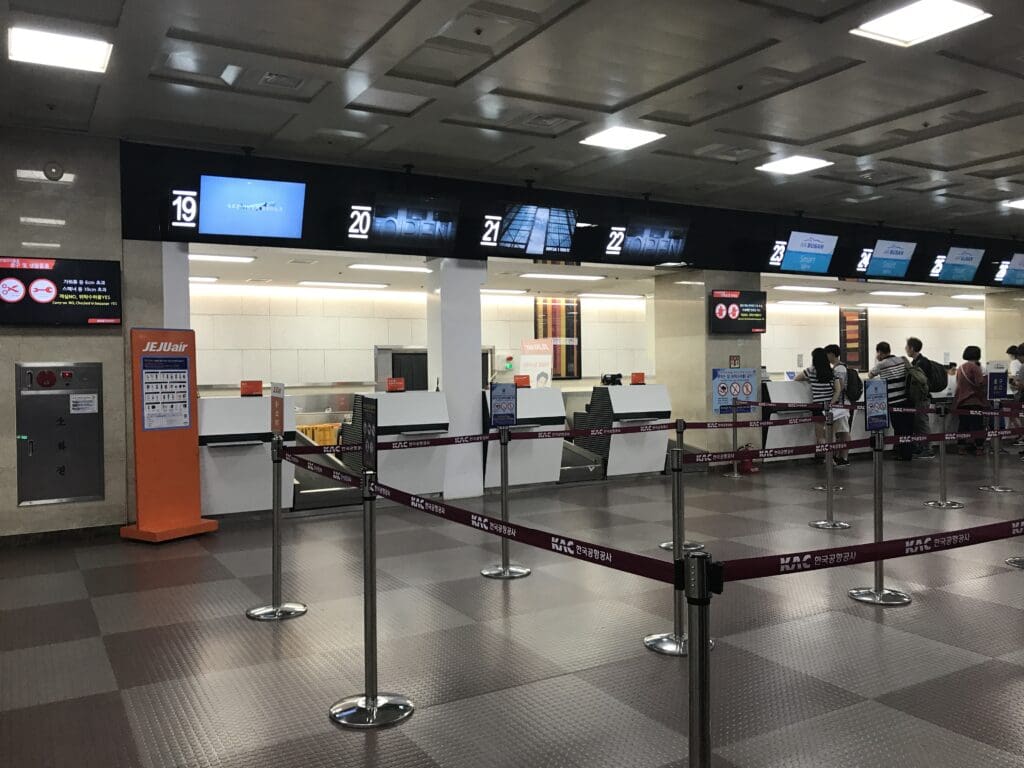
I received my boarding pass with around an hour to go until the flight’s scheduled boarding time. Seeing no reason to remain landside, I headed back up to the departure level where my first port of call was the usual boarding pass and ID check followed by security. Seeking to limit the number of people passing through the small zone between the landside and airside areas and minimise queuing there, only a certain number of passengers were permitted to enter this at a time. As a result, a ten-minute wait was required before I was able to have my boarding pass and passport checked before I was permitted to head to security. Once there, security was a breeze and I then headed up to one of the queueless immigration desks where my passport was checked by perhaps the friendliest immigration official I have encountered in any country. After my passport was returned, I headed through to the small, cramped, overcrowded departure area which made me partially regret passing through to the airside area so early.
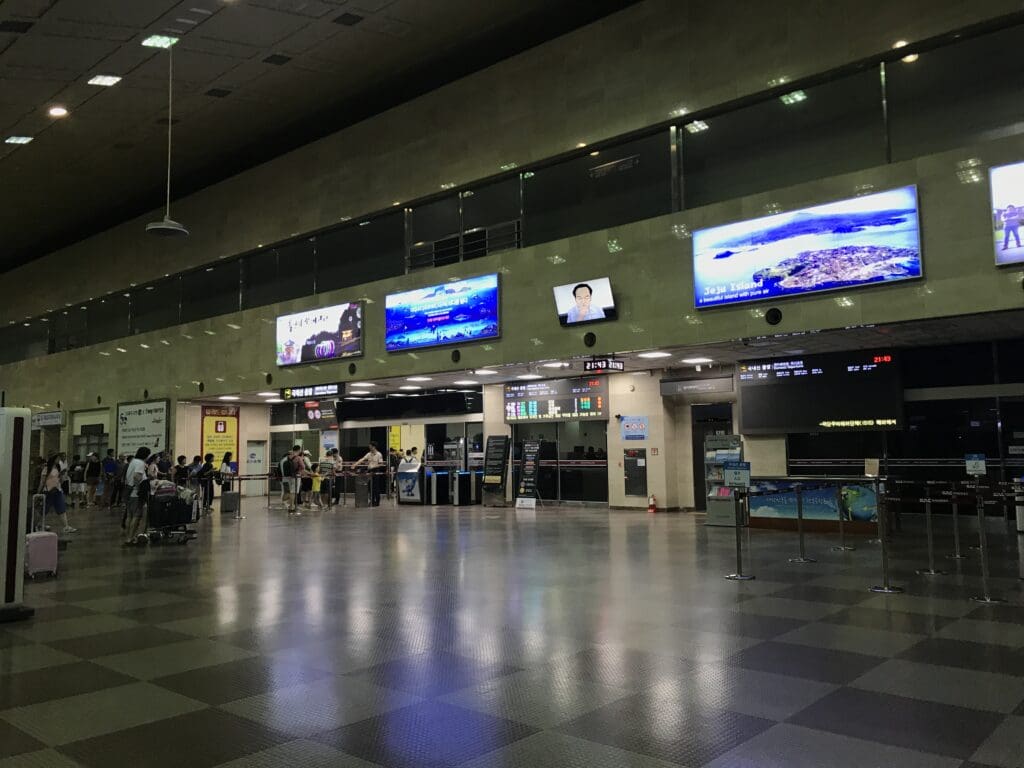
Aside from being rather busy and with few available seats, thanks to upgrade works the number of toilets appeared to be severely limited resulting in reasonably long queues to use these. However, on the plus side, the airport’s complement worked well for the duration of my stay. At 2220, the six-strong Jeju Air crew passed through security and proceeded to wait at the gate. With the Beijing flight serving as the final departure of the evening, by this time only those heading across to China remained. At this time, several members of Jeju Air’s ground staff passed through the terminal checking everyone’s boarding passes in order to find several passengers who had attempted to carry restricted items in their hold luggage. At 2250, the crew for the flight headed off down the jetway to the aircraft and six minutes later boarding for the flight was called. After joining a short queue, at 2305 my boarding pass was scanned and I made my way down onto the waiting aircraft.
That evening, the aircraft for the flight would be thirteen-and-a-half-year-old Boeing 737-8Q8 HL8287. This aircraft made its first flight from Renton in January 2004 and was flown across the Pacific later that month to fly with Australian LCC Virgin Blue where it was christened Blue Billie. When the airline transformed into Virgin Australia in 2011, the aircraft continued to fly with the airline for a further two years. In June 2013 the aircraft was flown from Malaysia up to Korea to begin its new life in the white and orange colours of Jeju Air. In the week before my flight, the aircraft had flown 66 flights flying around 30,000 miles visiting Bangkok, Busan, Cheongju, Daegu, Guam, Gwangju, Jeju, Seoul Gimpo and Tokyo Narita.
Upon stepping into the forward galley I was warmly welcomed aboard in both English and Korean before I made my way into the aircraft’s cabin. As with most Boeing 737-800s that are operated by LCCs, this was in an all-economy 189-seat configuration, and onboard seats were covered in a grey fabric on which a repeating pattern of various Jeju-related symbols could be seen. Each seat also featured a disposable antimacassar which featured the Jeju Air’s logo along with an advertisement for the airline’s Refresh Point frequent flyer program. Upon reaching seat 12D, I took my seat and was pleased to find that this was fairly comfortable and soft albeit with an LCC standard amount of legroom. Despite the aircraft’s age and busy schedule, I did not spot any signs of wear and tear about the cabin, whilst the aircraft appeared to have been cleaned well during its time on the ground. Turning to the seatback pockets, these contained a copy of Jeju Air’s duty-free catalogue, the August 2017 edition of the airline’s Join Enjoy inflight magazine and the Air Café menu as well as the usual safety card and sickbag.
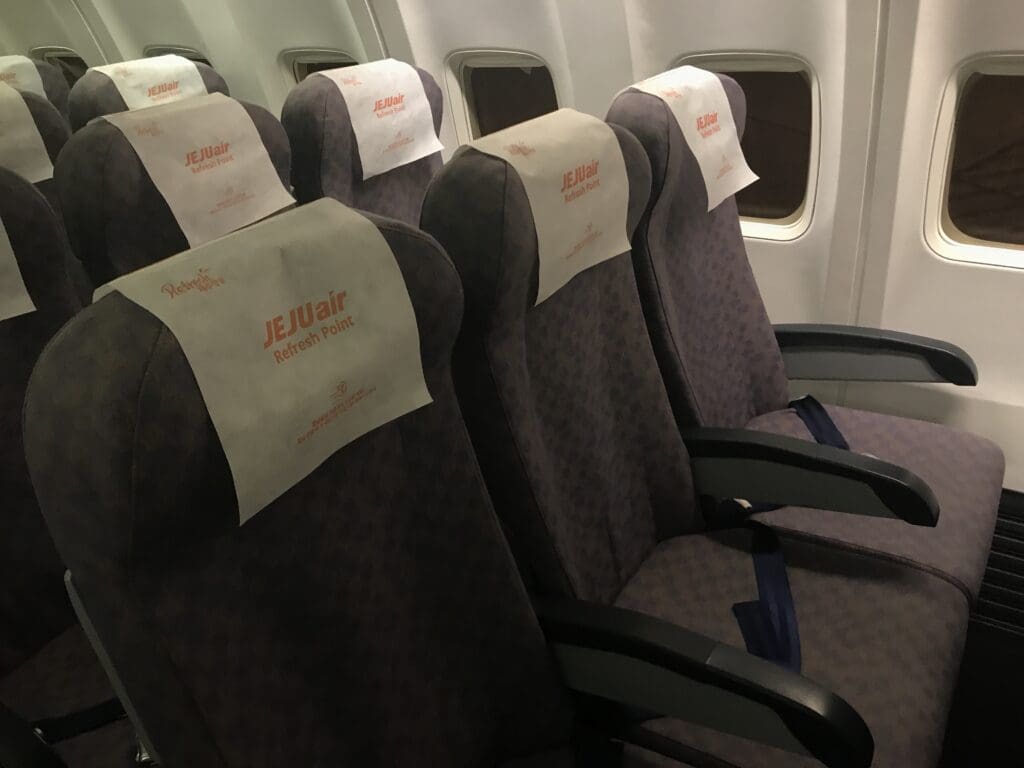

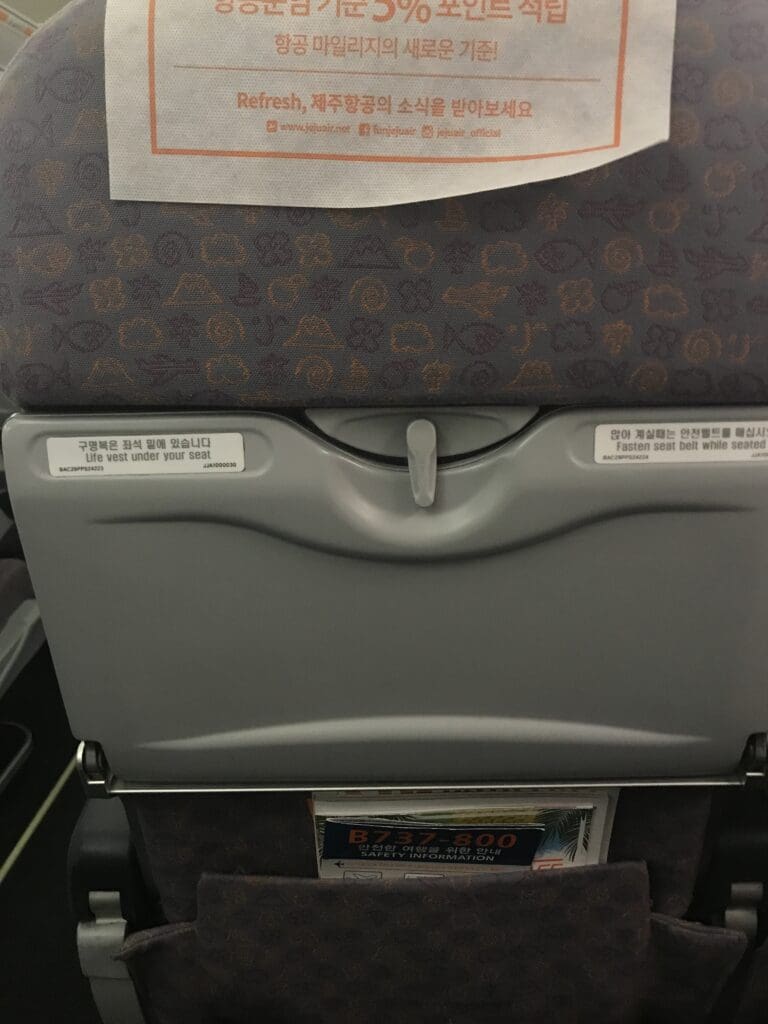
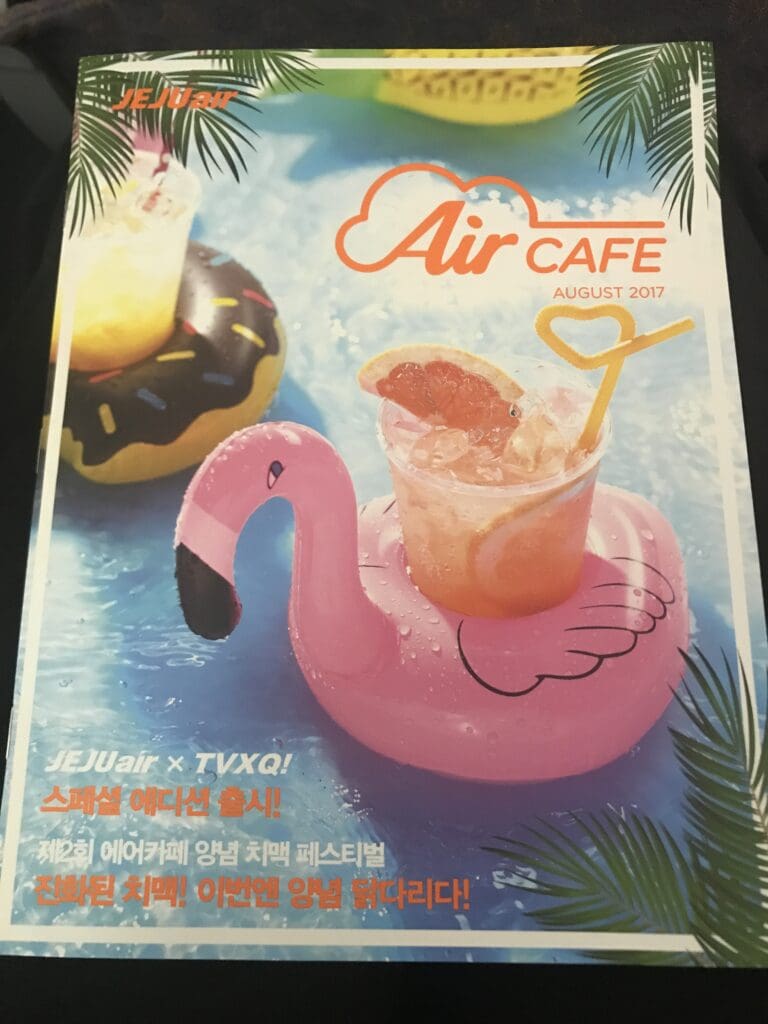
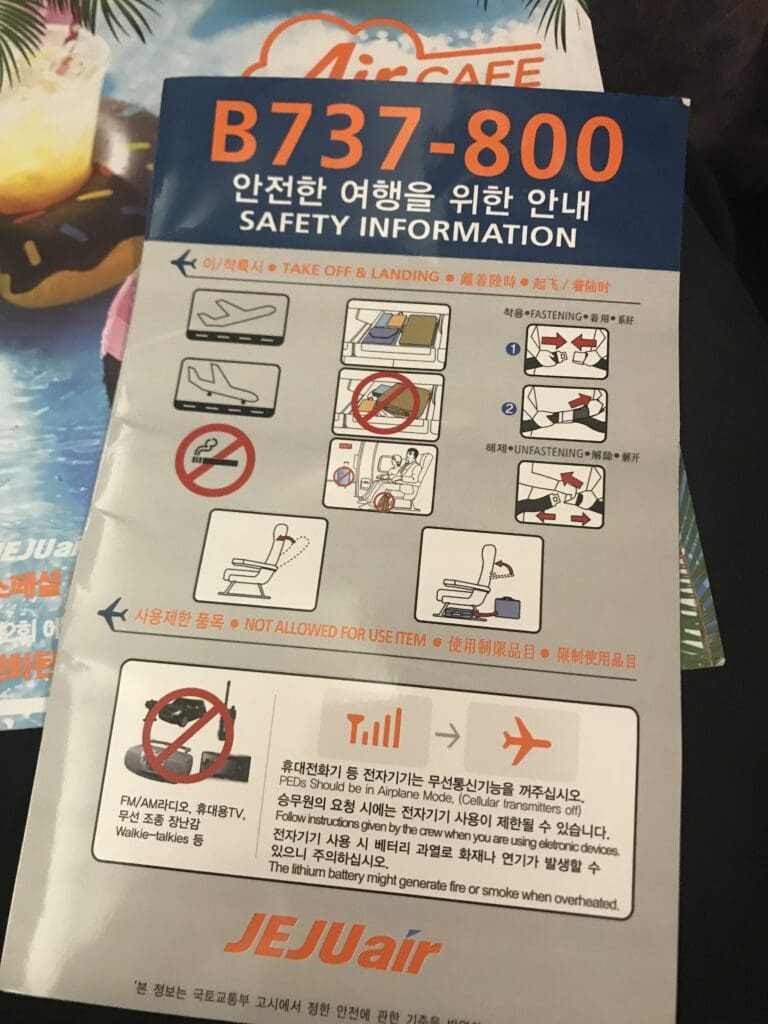
That evening, the flight over to Beijing appeared virtually full with around half of those onboard appearing to be from China, many of whom were fairly young tourists and students, whilst the majority of remaining passengers appeared to be from Korea. However, I did also notice several Mongolian passengers onboard the flight that evening. Meanwhile, all crew members appeared to be from Korea although one of the four flight attendants appeared to be able to speak a reasonable level of Mandarin. By 2315 the final bunch of passengers boarded the aircraft carrying with them massive amounts of duty-free items which they struggled to find space for and so the crew stepped in and stored these in the galley. Once all were onboard the L1 door remained open and there appeared to be some commotion at the front of the aircraft as a ground staff member rushed onboard in an effort to locate a passenger carrying a prohibited item in their hold luggage. Making the most of the Mandarin-speaking crew member’s skills, this issue was soon rectified and the main cabin door was closed at 2320.
Immediately after the L1 door was shut, the purser performed a welcome announcement in Korean and English, after which a safety announcement was performed in Korean and English which was accompanied by the usual demonstration. Five minutes after the doors were closed, the aircraft was pushed back and after coming to a halt, the jet’s two CFM engines powered into life in a fairly quiet fashion (although this was likely due to my position within the aircraft). A couple of minutes later the jet began its short taxi to the active runway, without pausing the Boeing made a powerful takeoff into the bright night skies above Daegu. Ten minutes after takeoff, once many of the passengers had dozed off to sleep the cabin lights were switched violently back on and the seat belt signs were switched off. I have to say, with regard to the lighting, this is probably one of the areas where the advantages of the newer Boeing Sky interior-fitted 737s are clear. The mood lighting on these aircraft allows the cabin to be gently lit allowing for service to be conducted without such sudden luminosity that causes light sleepers to awake.
As I have noticed is usually the case on Korean airlines, the captain delayed their welcome speech until the aircraft had reached its cruising altitude at which point we were informed of the weather enroute which included some thunderstorms around Tianjin as well as the flight time of 2H50. Whilst this is the scheduled flight time of the flight, such a long flight time was a little surprising given that the average flight time for Jeju Air flight 8101 was only just over two hours. I thus expected that the aircraft would have to deviate off the flight’s usual route due to thunderstorms or that the aircraft would have to hold for a while due to traffic in Beijing.
Just after the announcement was made, I felt the aircraft begin to turn starboard. I thought this to be a little unusual but I assumed it was to line us up with the airway that would take us north to Seoul before turning west. However, a few minutes later we then began another barely noticeable turn before flying straight and level for several minutes before turning again. This pattern continued for forty minutes high above the cities of Chungju and Jecheon. Whilst many passengers were blissfully unaware of our movements thanks to the lack of overhead screens on the aircraft, I was fully aware that we were in a racetrack holding pattern likely for one of two reasons. The first being that we were not yet cleared to enter the busy Chinese skies, and the second being that there may be a mechanical fault that would require a diversion. The latter prospect was slightly worrying, not just because of a potential mechanical problem but also because it would likely leave my entire travel plans in ruins.
As we aircraft held, the inflight service began reassuring me that the holding was simply for air traffic control purposes. This service consisted of a cup of water in a Jeju Air branded paper cup and items from the reasonably priced Jeju Air menu. Most passengers passed on ordering food which was understandable considering that those passengers starting their journey in Daegu likely ate their evening meal before heading to the airport. Jeju Air offers a wide selection of food and drink, with many of their lighter set meals costing no more than 10,000 won however their full hot meals are a little pricey costing up to 20,000 won. For those wanting to pretend they are on Korean Air, bibimbap is sold for 5000 won. Having had virtually nothing to eat since leaving Seoul, I opted for some jjajangmyeon. Surprisingly I could not order this with my Korean debit card leaving me to instead pay with either Korean cash or a credit card. Lacking both I had no option but to pass on the food offerings. Once the service was completed the crew turned off the cabin lights and I attempted to sleep, something which would have been easily possible were it not for the loud conversation of my two seatmates who broke the cabin’s silence. In order to pass the time I briefly flicked through the airline’s inflight magazine which featured a range of articles on destinations around the world. Rather pleasantly, this did not appear to be completely littered with advertisements as is often the case with the inflight magazines of many LCCs.
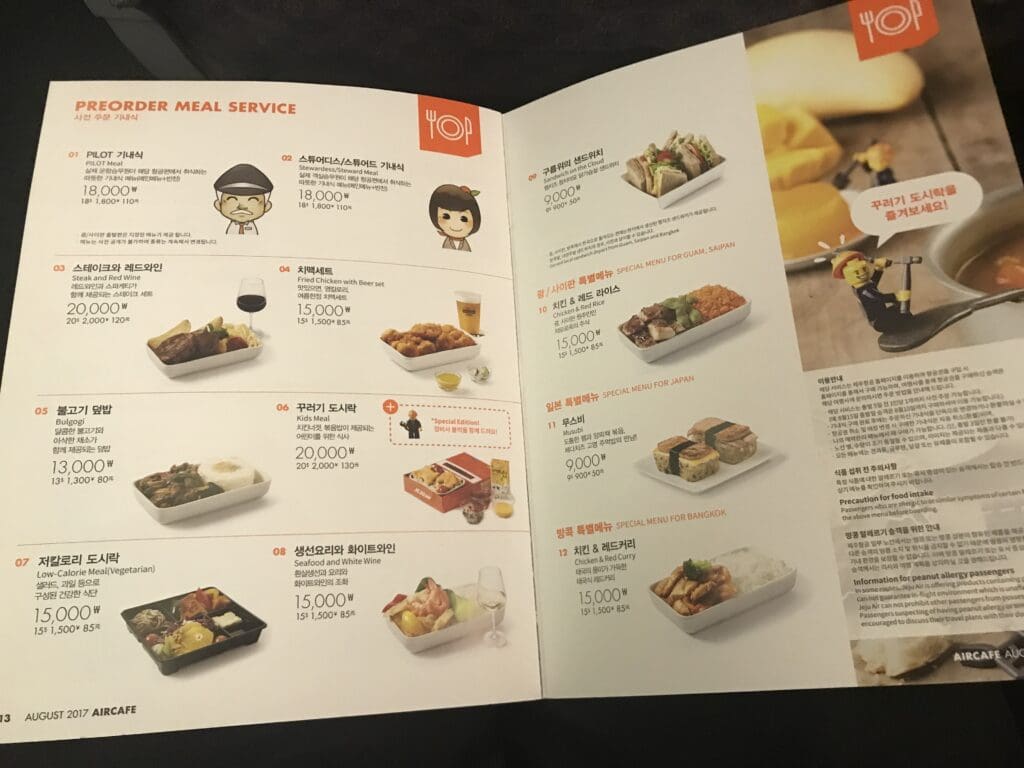
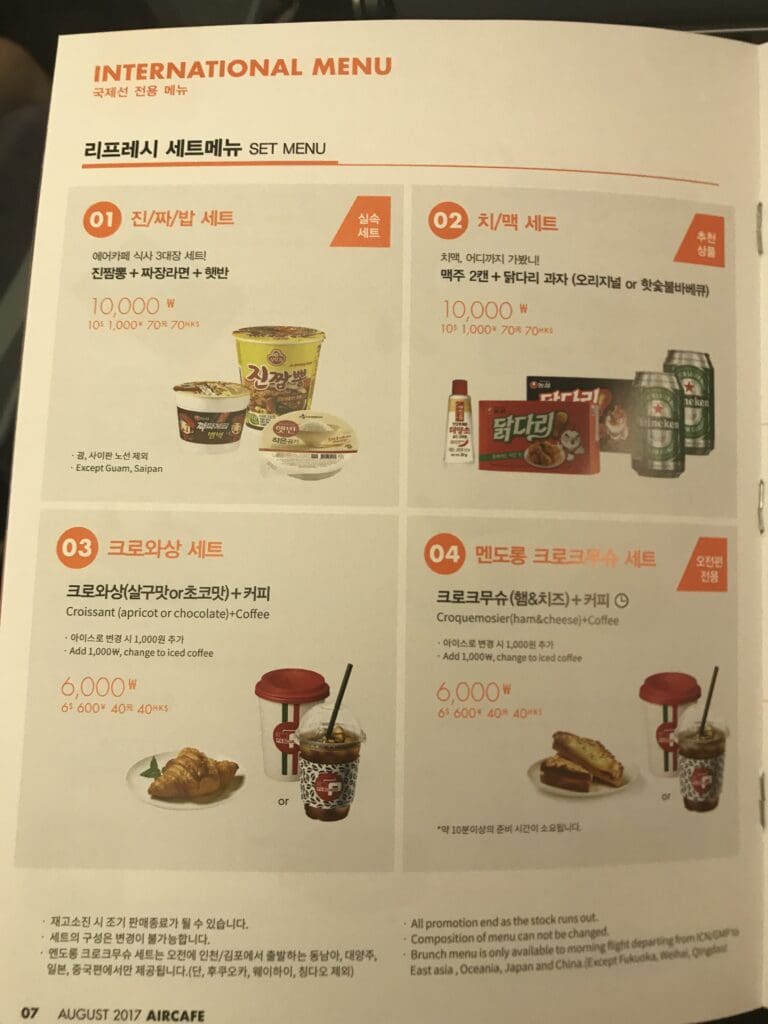
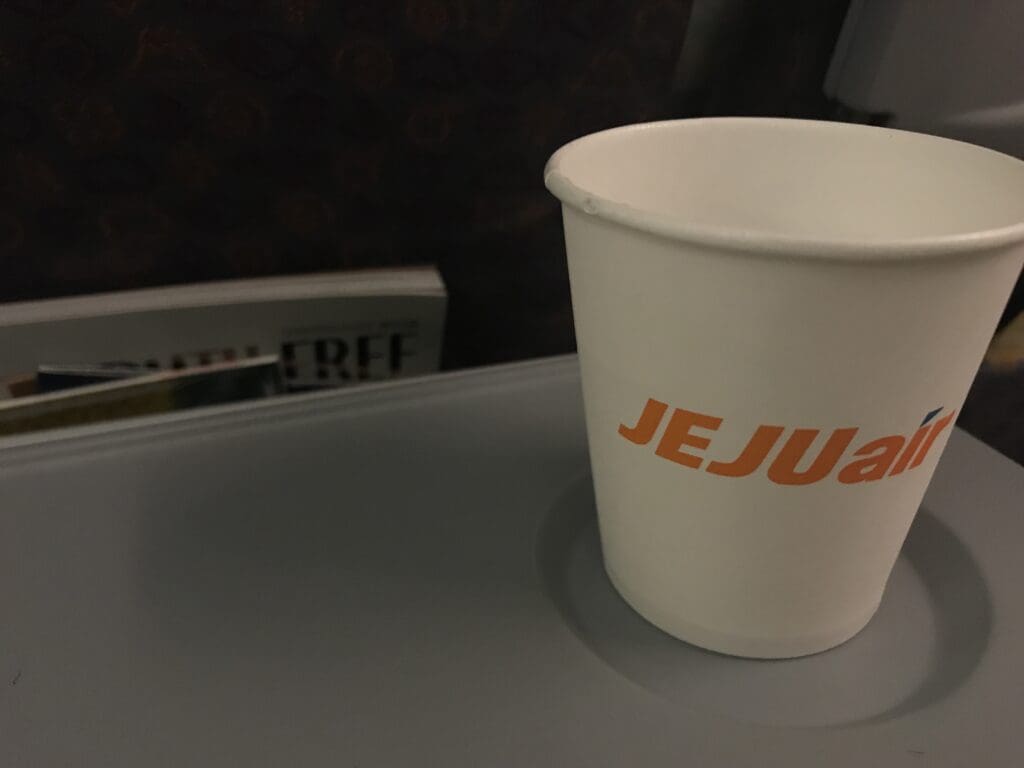
After five holding patterns the aircraft finally continued on its journey making a beeline for Seoul before turning directly westwards just south of the city passing over the city of Incheon and its airport after which it headed out over the dark Yellow Sea. As the aircraft cruised west, the jet hit a few patches of turbulence as we passed over the seat at a low cruising altitude of 30000 feet. Just over halfway into our crossing of the Yellow Sea as the aircraft passed in between the Shandong and Liaodong the aircraft entered another single holding loop and descended to 27,000 feet, although this time I remained oblivious to this and was only able to find this out by checking FR24. From there the aircraft then turned southwest and headed for the Shandong city of Dongying, home to around two million people. After heading west again towards Dezhou the jet continued its descent before heading almost directly north to Beijing. At this time the cabin crew once again switched on the cabin lights, made the usual descent announcement before passing through the cabin and ensuring all was in position for landing before switching the lights off again. As per usual when arriving in China, a symptom message was made in Korean and Chinese in an effort to prevent the global spread of infectious diseases.
During the descent, the cabin lit up several times thanks to the lightning from the storm that raged on outside the aircraft and the aircraft was thrown about a little as we headed down towards the capital. Once the Boeing sank beneath the clouds the ride smoothed out a little and before I knew it the flight was reaching its end, sinking down past terminal three and the masses of Air China aircraft before making a smooth touchdown on runway 36R in the midst of a heavy rain shower 2H56 after leaving Daegu. This was followed by some medium braking before we exited the runway towards its end. As the aircraft taxied off the runway the cabin lights were immediately turned on and the cabin crew performed a welcome announcement. From the landing runway, the taxi over to the international portion of Beijing’s Terminal 2 was rather short and took the jet past a host of Hainan Airlines aircraft, a UIA Boeing 767-300ER, an Aeroflot Airbus A330 and two Korean Air aircraft, a Boeing 737-800 and a Boeing 777-200ER that had arrived from Busan and Seoul Incheon respectively.
After coming to a halt at gate 213, the aircraft’s engines shut down and the sound of heavy rain hitting the top of the fuselage filled the cabin. At 0130 Beijing time, the front curtain opened and one by one passengers began to disembark. Upon reaching the front of the aircraft I thanked the same two crew members that welcomed me aboard before stepping onto the jetbridge. As it would turn out, it would be a very long night for the Jeju Air crew. Not only would the return flight to Daegu depart over three hours behind schedule, but upon arriving in Korea this would divert to Ulsan Airport before later heading the very short distance to Daegu. As I made my way up the jetway, I noticed an open door leading to the apron. Whilst I’m sure anyone foolish enough to attempt to go through it would be quickly apprehended, to see such a thing at one of the world’s busiest airports was a bit alarming.
As I stepped into the terminal a full load of passengers waiting for the flight back to Daegu could be seen on the other side of the glass partition. After heading up the escalators it was a reasonably long walk to immigration, upon my arrival a long queue could be seen. I took my place in the orderly line and waited to reach the front which took some time seeing as there was only one desk open for the queue I had joined. After around 25 minutes I reached the front and following a minute of waiting I entered China. Once in China, I headed down the escalators to baggage claim where my bag could already be seen happily spinning around, ignoring the fact that it was soaking wet from the rain showers outside.
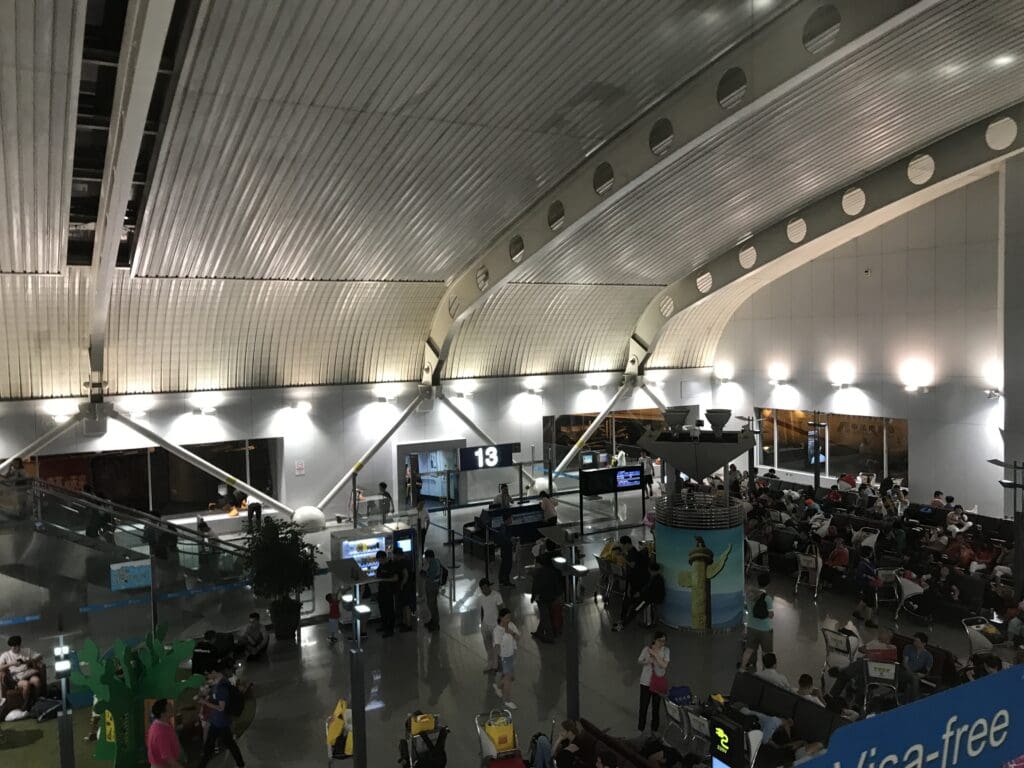
Summary
Whilst I realise Daegu Airport was in the midst of upgrade works and that the experience offered by this now may be vastly improved, at the time of my flight, this was not fantastic. Although the airport is in a fairly central location and was easy to reach having arrived in Daegu by train. Turning to the flight, for an LCC, Jeju Air’s service was relatively good. The crew onboard were polite and friendly and conducted their duties in an efficient and orderly fashion. The aircraft appeared to be well kept and was spotlessly clean upon boarding so I have nothing to complain about here and would thus happily fly with Jeju Air again in the future – in fact, I have already done so from Busan to Jeju!

